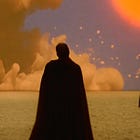Maps, Flaps, & Infinite Wallpaper
Set design that folds neatly away in the mind.
Written by Graeme Cole for Unfound Peoples Videotechnic.
A 12-part series on the foldable, flappable, and collapsable labyrinthine potential of movie set design. Interlocking but detachable micro-essays on how the filmmaker might fill the space between the image surface, the characters, and the horizon.
Choose from 35 micro-essays, including notes on:
🏗️ How to design the bottomless pit into which you'll toss your actors, and why to use plasticine.
📦 Clunkyism: the power and pathos and affordability of wretched materials.
🗺️ Set as city, city as map, map as narrative, and narrative as set design.
🚧 Open worlds, filler areas, and mirror diegetics.
Evergreen, esoteric knowledge, first published in the spring of 2024.
Index
Read in any order.
Underlined links lead to individual micro-essays within the containing lesson (anchorpoints).
Empty sets | A film without actors is like a person without clothes: everyone stares at the set design to see if the furniture matches the themes.
Sketching | The guiding principles you might choose when sketching your set design.
Modelling | Sketching your production design by modelling ‘off paper’ can lead you to imagine secret flaps and hideaways in your set.
Space | You might not think to add space to your set design because a movie is flat. But you must! You must!
Physical space | There are many ways to add or alter space in your movie, some requiring more muscle power than others.
Space:character | Reducing character space increases the friction they encounter - for better or worse.
Conceptual space | The understanding that other people need somewhere to hang their imagination in your movie.
Cardboard | Why cardboard is so great.
“Cardboard consciousness” | Potato Wolf, Paper Tiger, production sympathy, and the cardboard alienation effect.
Cardboard trees | Where cardboard comes from in the origin story of your hero’s cardboard-built universe.
Cardboard dialogue | How to adjust your movie’s dialogue to make the cardboard feel at home.
Cardboard performances | Why you might try to “rip” or “dent” your actor’s performance.
Clunkyism | An aesthetic principle that involves involves isolating the discrete components of any aspect of a movie’s production and giving them extra clunk.
Wallpaper | The problem of walls, which fill so much of the average cinematic shot, and which need to be covered.
Wallpaper or not | The multifarious power of wallpaper, which is extendable, structural, decorative, and may be hardwired to the cosmos.
Wallpaper sense | The mental and emotional risks (and potential) of gazing for too long into the infinite shroud.
City concept | A city needn’t look like a city to still be a city. The concept of city comes before the aesthetic.
Window framework | Building a city from the shadows up.
City detail | City design in filmmaking requires a careful balance of attention to detail, reckless copy-pasting, and smudging out of the unnecessary.
City map | A movie maps the city in which it is set; if your character should see this map, all hell could break loose.
City bus | If you really want your hero to see the city, force him to take public transport.
Mapping | Your film is a two-dimensional map, whether you like it or not.
A map for a film set | How Peter Greenaway made an entire film using actual maps, and the places are realer than CGI.
Treacherous geography of memory | How Guy Maddin mapped his father’s memory with wallpaper
Hell map | How Béla Tarr mapped Hell onto a quaint Corsican port town.
Maps within maps | A recursive world-within-a-world structure can reinforce your themes while saving money on set construction.
Reverse forensics | Imagining what happened to make each set detail look the way it does is a full-time job - best outsourced to a murder detective.
Filler areas | Something must exist in all the places just beyond the edge of your movie, and it’s possible your characters can smell it.
Reverb (Fog) | The smoke machine both accentuates and smudges the contours and volume of your cinematic spaces.
Mirrors | A mirror in a movie might be a portal into alterity or a stray notion of the main picture.
Designing for pause | There’s something in designing a movie to be paused and studied - as long as the still frame carries the tension of the straining pause button.
Environments | The costume designer may see houses and castles as just very big frocks.
The character is almost a location | The character may arrive in a fragile location with their own powerful force of gravity.
Resolution for all | The director of photography (DoP) may drape the set designer’s work in a cloak of high resolution - recalibrating the nature of the fixtures and fittings.
Set resolution | The set designer can undermine the DoP by designing low-resolution fixtures and fittings.
Modernity | Georgian filmmaker Otar Iosseliani set his camera in a doomed village and let zealous town planners do the set construction for him.
Futuristic fixtures | Science fiction furniture requires science fiction furniture showrooms.
Quivering unhatch | Real movie sets are designed to crumble at a moment’s or a lifetime’s notice.
Backstory of doom | Every design element should have its own backstory, but also its own obituary written into its DNA.
🦋 Bluesky | 🐦 Twitter | ⏰ TikTok | 📸 Instagram | 😐 Facebook | 🎞️ Letterboxd | 🌐 unfound.video




























